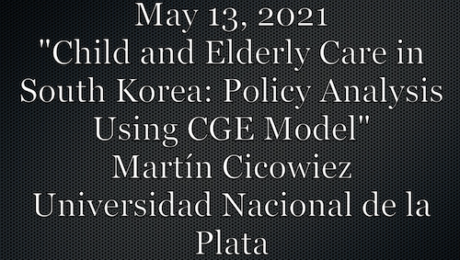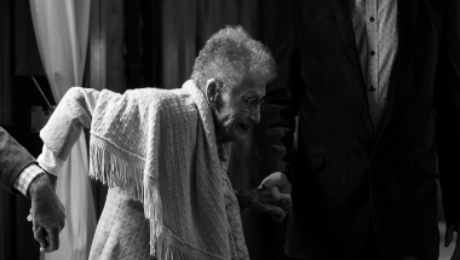Child and Elderly Care in South Korea: Policy Analysis Using CGE Model
In Korea, fertility is constantly decreasing, and it is currently very low, the size of the elderly population is going up, and at the same time, the size of the child population is going down, the gender wage gap is the highest among the OECD countries at about 35%. Given this context, Dr. Martin Cicowiez (Universidad Nacional de la Plata) discussed a computable general equilibrium (CGE) model for South Korea developed with Hans Lofgren (World Bank) that assessed the impact of different policies related to childcare, elderly care, and the gender wage gap on the distribution of paid care and unpaid care in households, on the second day of the Concluding Annual Meeting.
Dr. Cicowiez stated that a well-structured and disaggregated model could capture the role of government policies in addressing these challenges and further inform policymaking by establishing links between care, female labor force participation, gendered wage discrimination, and social and economic outcomes such as household wellbeing.
The model features three representative households based on their care needs: working-age head with children, working-age head without children, and elderly head. And three simulations: increase in government spending on childcare, increase in government spending on eldercare, and a decrease in the wage gap by 50%. The results show an increase in time spent on paid work for both men and women if there is an increase in government spending on childcare and this increase is higher for females. The effects of increased government spending on elderly care and a decrease in the wage gap are similar but relatively smaller. All three simulations demonstrate a switch from unpaid care to market care services. It is worth noting that females experience decreased leisure when the analysis includes time spent on leisure activities. These results underscore the tradeoffs of macroeconomic policies targeted at care work.
To watch the full presentation, see below.
Written by Praveena Bandara, Research Assistant for the Care Economy Project and PhD student in Economics at American University.
- Published in Conferences, Economic Modeling, Expert Dialogues & Forums, Policy, Rethinking Macroeconomics
What is the Care Economy and Why Should We Care?
In our project, we aim to promote and advocate for gender and socioeconomic equalities. We do this by working to reduce gender gaps in economic outcomes and by showing and properly valuing social and economic contributions of caregivers; and integrating care into macroeconomic policy making toolkits.
In this era of demographic shifts, economic change and chronic underinvestment in care provisioning, innovative policy solutions are desperately needed, now more than ever. Sustainable and inclusive development requires gender-sensitive policy tools that integrate new understandings of care work and its connections with labor market supply and economic and welfare outcomes.
The Care Work and the Economy Project, currently based at the Economics Department of American University and co-led by Maria S. Floro and Elizabeth King, includes more than 30 scholars around the globe, working closely together to provide policy makers, scholars, researchers and advocacy groups with gender-aware data, empirical evidence and analytical tools needed to promote creative macroeconomic and social policy solutions. In the next phase of the project, Care Economies in Context, we will be scaling up our project to include 8 different countries, in 4 global regions. I will be leading this next phase of the project, which will be based at the University of Toronto.
I define Care work is defined broadly as work and relationships that are necessary for the health, welfare, maintenance and protection of all people – young and old, able bodied, disabled, and frail. This definition may seem broad – but care– at its core is a very basic human need and a necessity. Whether we know it or now, we all participate in providing care work – paid or unpaid, and in receiving care every day.
By care economy, I am referring to the sector of economy that is responsible for the provision of care and services that contribute to the nurturing and reproduction of current and future populations. More specifically, it involves child care, elder care, education, healthcare, and personal social and domestic services that are provided in both paid and unpaid forms and within formal and informal sectors.
Care work is important because it is important work that sustains life. It is also important now in particular because it is one of the fastest expanding economic sectors and a major driver of employment growth and economic development around the world. For example, across the OCED, the service sector economy now accounts for over 70 percent of total employment and GDP. In lower- and middle-income countries, it is estimated to comprise nearly 60 percent of GDP. Within the service sector economy, care services is one of the fastest growing subsectors.
The International Labour Organization (ILO) estimates that the global employment in care jobs is expected to grow from 206 million to 358 million by 2030 simply based on sociodemographic changes. The figure will be even more dramatic to 475 million if governments invest resources to meet the UN sustainable development goal targets on education, health, long-term care and gender equality.
In Canada, the service sector already makes up for 75 percent of employment and 78 percent of GDP. Within this sector, healthcare, social assistance and education services are key drivers of economic and employment growth. In the U.S., healthcare is already the largest employer, larger than steel and auto industries put together. In short, our current and future economy is and will be increasing dominated by care services and care work.
However, at the same time, much of the care work continues to be performed for no pay, by families and friends, at home and in communities. This unpaid care work is not including in in our national GDP because GDP only takes into account work that is done for pay in the formal market. Therefore, if we only look at the GDP as a measure of the economy and economy growth, we miss a huge segment of the economy and economic activities. As the pandemic has shown, without both paid or unpaid care work, our economy will not be able to function effectively, nor would it be able to sustain itself.
What we are trying to do in our project is to make the care economy clearer and more visible by measuring and mapping out the size and shape of the economy, and to develop macroeconomic models that would help policymakers and civil society actors to develop better policies and better strategies to ensure more sustainable and equality inducing economic growth.
Listen to the full talk “The Care Work and the Economy Project” to learn about what the care economy is and why we should know more about it, particularly now.
The blog was authored by Ito Peng, contributing researcher for the Understanding and Measuring Care research cluster
- Published in Canada, Child Care, Economic Modeling, Elder Care, Expert Dialogues & Forums, Feminist Economics, OECD
Macroeconomic Policies, Care and Gender in the Post-COVID Era: Part II
Faculti, an organization that presents digital media from leading experts and academics outlining their work, recently released a digital presentation by the Care Work and the Economy Principal Investigator Dr. Maria S. Floro entitled “Macroeconomic Policies, Care and Gender in the Post-COVID Era.” The discussion describes the interconnections between the crisis of care, the deepening ecological crisis and growth and accumulation processes.
There are many common threads with the climate and ecological crisis and the care crisis. Significantly, the idea that economic growth is overall beneficial. The type of economic growth generally pursued worldwide has not only increased stresses put upon the earth’s resource base but also on care labor capacity, which is similarly but wrongly perceived to be of infinite supply. Moreover, arguments that equate economic growth with overall improvement fail to recognize the distributional element of rising income inequality, which is far more nuanced. In fact, among countries that are higher income, gains from economic growth within those nations do not trickle down to everyone. When looking at care, the widening income equality gaps has shifted distribution of care givers across social classes and national boundaries. As a result, the quality and adequacy of care within a single nation can be very different, which exacerbates differences in social reproduction.
At the same time, income inequality has created a solution for the care needs of those that have the means to hire care for children and elderly, because care workers in those sectors are often paid low wages. But for the working poor, hiring care work help is inaccessible due to financial constraints, therefore they rely on their kinship networks to help provide this care. Furthermore, much of the care work burden still falls on women even as they enter to labor force. Economics and social policy in many parts of the world continue to neglect the heavy work burden put upon women and the necessity to balance household care activities and market work. What can also be observed is a global care supply chain, with the migration of women and girls to urban areas to provide care for wealthier families. Care itself is becoming one of the drivers of income inequality.
The economy is not all about material production; it is really about human vision and social provisions. However, an illusion has been created that unpaid care work is a natural resource that serves as an input for market production to promote GDP growth. However, this idea does not take into account that the wellbeing of people, especially the elderly, the sick and children should be an end in and of itself, to achieve sustainable growth. There is much work to be done to address these issues. To begin, economists must envision long term horizons that look forward to future generations while also taking into account the interdependence of life and moral responsibility. They must also integrate care and environmental consequences into our economic policy tools. Overall a new economic paradigm that includes green ecology and feminist economic concerns is needed.
Link to Part 1 of this blog here.
Reflections on Parental Caregiving and Household Power Dynamics
A growing concern in many countries is an aging population and an increase in the number of elderly in need of long-term care. However, the impact of elderly care on the well-being of care providers remains relatively understudied. One of the primary factors which complicate analysis is that a majority of elderly care is provided informally by family members, with adult children often comprising the largest share of care providers. The pervasiveness of unpaid care due to cultural or family ties has even limited the development of long-term care insurance in economically advanced regions like Europe. However, while children may provide an informal safety net, parental caregiving is a time-intensive task and must be met by adjustments in leisure or work hours on the part of the care provider. Hence, in order to understand the full macroeconomic implications of growing elderly care needs and the appropriate policy response, it is imperative to understand how households cope with these caregiving needs.
Economic models of elderly care have focused almost exclusively on inter-generational bargaining between parents and children or bargaining among siblings. However, little attention has been paid to the influence of care demands on the power dynamics between partners within a household (e.g. husband and wife). This is despite data showing that caregiving falls disproportionately on women and that some caregivers respond to increased parental care needs by reducing work hours, taking more flexible jobs, or by quitting paid work entirely. Moreover, caregiving may have spillover effects on the caregiver’s spouse or partner. For example, a spouse may work longer hours or reduce their spending to cope with fewer hours of paid work by the caregiver. So it is unclear to what extent partners reallocate their time and resources and share the burden of parental care needs when they arise.
In the study detailed in the CWE-GAM working series paper published May 2020, we develop a theoretical model to explore how unpaid parental caregiving can affect the allocation of time and resources across partners under different household power structures. As parental caregiving disproportionately falls on daughters, we consider a model in which a woman’s parent is in need of time-intensive care. The provision of care across partners is then a bargained outcome between the couple. We not only examine how power dynamics and work arrangements impact caregivers and their partners but also how these factors may influence unmet care needs and care recipients.
After developing our model, we use cross-country data from the Survey of Health, Age-ing, and Retirement in Europe (SHARE) to illustrate our theoretical concepts with some numerical exercises. Broadly our results indicate caregivers may face a “triple burden” of market work, domestic chores, and caregiving. For example, our model predicts that for a duel-earning couple in France, the total cost of unpaid parental caregiving to the male is only about 57% that of their female partner—a skewed but shared burden. The higher cost to the female stems from two sources; (1) relatively fewer hours of leisure due to her provision of unpaid care; (2) the additional mental or emotional cost of leaving her parent with some level of unmet care needs.
Overall, our theoretical and numerical results show that ignoring bargaining power differentials across partners can misrepresent the true cost of unpaid parental caregiving by not taking into account the uneven distributional consequences. Moreover, our cross-country findings suggest that lower female bargaining power results in a larger burden on female caregivers and additional unmet care needs for their parents. If bargaining power is determined by relative earnings, government policies subsidizing long-term care could decrease the well-being gap within a household by providing financial relief and improving the bargaining position of the caregiver. This could further result in reduced levels of unmet care needs and improved outcomes for elderly care recipients. We further show that inflexible work arrangements also exacerbate the total cost of unpaid caregiving to the household as well as the unequal distribution of the burden. This implies policies that promote flexibility, such as caregiver leave or part-time options, could provide substantial relief, particularly to high-intensity caregivers.
This blog was authored by Ray Miller and Neha Bairoliya, who are both expert researchers for the Care Work and the Economy Project within the Rethinking Macroeconomics working group. To learn more read the CWE-GAM working paper upon which this blog was based here.
- Published in elderly care, Rethinking Macroeconomics






